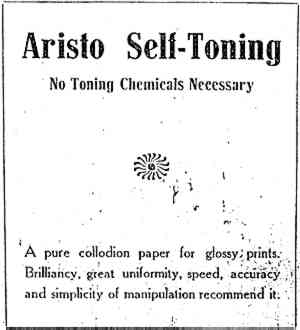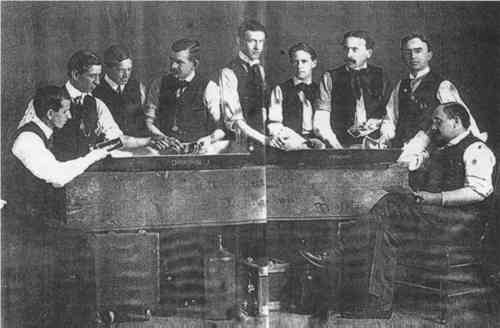DIFFERENCES IN IMAGE TONALITY PRODUCED BY DIFFERENT TONING PROTOCOLS FOR MATTE COLLODION PHOTOGRAPHSSYLVIE PENICHON
3 COLLODIO-CHLORIDE PAPERSThe first use of collodion as a binder for paper prints can be attributed to Antoine Gaudin, who described his method of preparing collodion photog�ne—a name he applied to “any sensitive compound containing nitrate of silver”—in the pages of La Lumi�re of September 1861 (quoted in Harrison 1887). Collodion was a substance already known by the photographic community, for it was used as a binder in processes such as the ambrotype, the tintype, or the wet collodion negative. In these processes, a solution of collodion containing potassium iodide was poured over a metallic or glass support and immediately dipped in a sensitizing bath of silver nitrate. The difference in Gaudin's experiment was that the sensitizing bath was dispensed with by the inclusion of light-sensitive silver salts within the collodion binder, and the emulsion was ready for use at once. On March 17, 1865, George Wharton Simpson, editor of Photographic News, presented a paper entitled “On a New Method of Printing and the Preparation and Use of Collodio-Chloride of Silver,” at a meeting of the London Photographic Society. In his presentation, Simpson stressed the difficulties of obtaining consistent results with the floating method currently used with albumen papers, because every sheet floated over a sensitizing solution changed the composition of this solution. With one batch of emulsion this problem would disappear. The first sheet of paper coated had the same properties as the last one. He explained:
Simpson experimented with a wide variety of papers, including “Whatman's drawing paper, Turner's Calotype paper, Bristol-board, common writing paper, ordinary Saxe and Rive paper, and the paper prepared with arrowroot for the Wothlytype process” (Simpson 1865, 122), which he coated with his collodion emulsion. The best samples he presented at the meeting were made on paper sized with arrowroot starch, which provided a better adhesion of the emulsion to the paper and gave the surface an evenness not achieved with unsized papers. The prints aroused great admiration, but the process was not disseminated until several years later. Around 1866, the Soci�t� Leptographique introduced in France the Leptographic paper, invented by two photographers in Madrid, Jos� Martinez-Sanchez and Jean Laurent (Werge [1890] 1973). The paper was a modification of Simpson's collodio-chloride recipe and one of the first printing-out papers to make use of barium sulfate in its manufacture By the end of the 1870s, the commercialization of ready-to-use gelatin dry-plate negatives provoked a rapid expansion of the market. The growing number of amateur photographers instigated an enormous demand for ready-made photographic papers (fig. 2). This demand induced the improvement and mass production of both collodion and gelatin POPs (Wentzel 1960). In 1884, Paul Eduard Liesegang of Dusseldorf started the manufacture of a fine collodion emulsion printing paper called Aristotype, from the Greek aristos (best) and tupos (type). A formula of POP using gelatin was published in 1882 by W. Abney, an English photochemist. Gelatino-chloride paper was introduced in England by Ilford Ltd., in 1885, and soon after in other countries (Sturge 1977, 5). Machine production of collodion POPs on continuous rolls did not start until 1889, when Dr. A. Kurtz introduced his glossy Celloidin paper in Germany (Eder [1932] 1972; Nadeau 1989, 61). Technology for the production of collodio-chloride POP in the United States was introduced by Carl Christensen. After the American Aristotype Company was founded in 1889, other smaller companies followed, including Kuhn Crystallograph of Springfield, Missouri; Western Collodion Paper of Cedar Rapids, Iowa; Bradfisch Aristotype of Brooklyn, New York; United States Aristotype and New Jersey Aristotype, both of Bloomfield, New Jersey (Jenkins 1975, 87). Production of gelatin-chloride papers followed in the early 1890s. Both papers were initially produced with a glossy finish that appealed to the taste of the 1880s. American Aristo and its later varieties, Aristo-Platino, Aristo-Carbon, Aristo-Junior, etc., all collodio-chloride papers, were
Self-toning collodion papers were first introduced in Germany by W. M. Ashman and B. Offord in 1885 (Wentzel 1960, 69) and became very popular with amateurs because they were fixed and toned in the same bath without any washing or other preliminary treatment (fig. 3). The basis of the emulsion for these papers was “fulminating gold [gold fulminate], together with chloride and silver nitrate, citric acid, and glycerin dissolved in collodion” (Salmon 1921). The gold salt contained in the emulsion was reduced in the fixing bath, which toned the image, preventing the need for a separate bath. One great merit of self-toning papers was the evenness of tone available throughout a series of prints (Photo-Miniature 1910). Some self-toning papers were also prepared with salts of selenium or tellurium (Clerc 1937, 356).
The diffusion of ready-made photographic paper was rapid within the amateur market, but it progressed more slowly among the professionals, who were reluctant to adopt it. Although collodio- and gelatin-chloride papers had many advantages over the albumen process (including ease of use, evenness of coating, more stability, increased sharpness of details in the shadows), years of practice with the latter led to its domination of the marketplace. With the new paper, everything had to be started over. Numerous articles and letters published in photographic journals attest to the suspicion photographers had toward machine-made emulsion paper, as illustrated by these comments:
Wide adoption of sensitized papers by commercial photographers did not come about until the early 1890s (Jenkins 1975, 81). At the same time, the public developed a taste for the matte papers and neutral black tones that were characteristic of the platinum print. This process had gained the favor of artists such as Clarence White, Frank Eugene, and Henrich Kuehn, but the prohibitive price of the metal was incompatible with commercial practice. The process was also judged to be lacking in sharpness and contrast for commercial portraiture. Matte collodion papers that had the platinotype's matte surface and neutral image color were introduced around 1894 (Nadeau 1989, 71) to answer both aesthetic and economic needs. By the end of the decade, their use was predominantly for portraits. In 1907, we learn that “probably 75% of the printing paper used by American professional photographers is Aristo-Platino,” a matte collodio-chloride paper (Photo-Miniature 1907). The situation lasted until about 1910, when printing-out papers were supplanted by faster gelatin developing-out papers (Reilly 1986, 12). (See fig. 4.)
|


